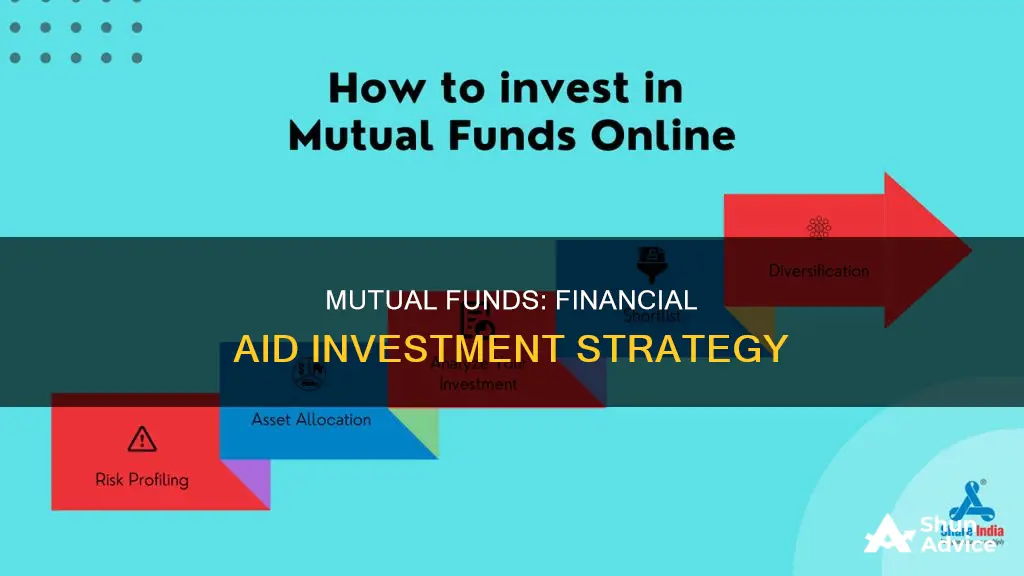
Mutual funds are a popular investment vehicle for those looking to diversify their portfolios. They are a type of investment that pools money from multiple investors to purchase a range of assets, such as stocks, bonds, or other securities. The funds are managed by financial experts who use the pooled money to buy a variety of assets according to the fund's investment objectives and strategy. Mutual funds offer investors a reliable, cost-efficient, and diversified way to grow their investments.
| Characteristics | Values |
|---|---|
| Definition | A mutual fund is an investment vehicle that pools money from multiple investors to purchase a diversified portfolio of stocks, bonds, or other securities. |
| Management | Managed by professional fund managers with expertise, experience, and resources to actively buy, sell, and manage investments. |
| Accessibility | Investors can buy mutual fund shares from the fund itself or through a broker. |
| Affordability | Most mutual funds set a relatively low dollar amount for initial investment and subsequent purchases. |
| Liquidity | Mutual fund investors can easily redeem their shares at any time, and the fund usually must send payment within seven days. |
| Types | Money market funds, bond funds, stock funds, and target date funds. |
| Benefits | Professional investment management, diversification, and three ways to earn money: dividend payments, capital gains distributions, and increased NAV. |
| Risks | All funds carry some level of risk. Investors may lose some or all of their money due to fluctuations in the market. |
| Fees | Annual fees, expense ratios, or commissions, which lower overall returns. |
What You'll Learn

Mutual funds on the FAFSA
When it comes to the Free Application for Federal Student Aid (FAFSA), some types of student and parent investments are reported, while others are not. Mutual funds fall into the category of investments that must be reported as assets on the FAFSA. This includes money in mutual funds owned by both the student and their parents, as well as any other accounts owned by the parents for any member of the household.
Mutual funds are investment vehicles that pool money from multiple investors to purchase a diversified portfolio of stocks, bonds, or other securities. They are managed by professional money managers and provide investors with access to a wide range of assets. By investing in mutual funds, individuals can gain exposure to professionally-managed portfolios and benefit from economies of scale, while also spreading risk across multiple investments.
When reporting mutual funds on the FAFSA, it is important to include the current market value of the investment. However, it is important to note that not all investments are reported as assets on the FAFSA. For example, the net worth of the family home, qualified retirement plans, small businesses owned and controlled by the family, and certain education savings accounts are excluded from the FAFSA.
It is also important to understand the fees associated with mutual funds, as these can significantly impact the overall investment returns. Mutual funds typically charge annual fees, expense ratios, or commissions, which can lower the overall returns. Therefore, when considering mutual funds as part of an investment strategy for education funding, it is crucial to carefully review the fund's prospectus, fees, and potential risks.
Mutual Fund Investment: Current Smart Choices
You may want to see also

Mutual fund fees
Mutual funds charge fees and expenses that lower their overall returns. These fees can be broadly divided into two categories: annual fund operating expenses and shareholder fees.
Annual Fund Operating Expenses
These are ongoing fees that cover the cost of paying fund managers, accountants, legal fees, marketing, and other administrative costs. They are typically between 0.25% and 1% of your investment in the fund per year. These fees are detailed in the fund's prospectus under the heading "Annual Fund Operating Expenses" and include:
- Management fees: The cost of paying fund managers and investment advisors.
- 12b-1 fees: Fees capped at 1% that cover the cost of marketing and selling the fund and other shareholder services.
- Other expenses: These may include custodial, legal, accounting, transfer agent expenses, and other administrative costs.
Shareholder Fees
These are sales commissions and other one-time costs incurred when buying or selling mutual fund shares. They are detailed in the fund's prospectus under the heading "Shareholder Fees" and include:
- Sales loads: Commissions paid when buying or selling mutual fund shares, also known as front-end or back-end loads.
- Redemption fee: Charged when selling shares within a short period of purchasing them.
- Exchange fee: Charged when transferring shares to another fund within the same fund group.
- Account fee: Charged for maintaining your account, often when the balance falls below a specified minimum.
- Purchase fee: Charged at the time of purchasing shares, distinct from a front-end sales load.
Invest in Fidelity: New Millennium Fund for Future Growth
You may want to see also

Mutual fund diversification
Diversification is a key investment strategy for reducing systematic risk in a portfolio while maintaining expected returns. A diversified fund is an investment fund that is broadly invested across multiple market sectors, assets, and/or geographic regions. It holds a breadth of securities, often in multiple asset classes. Its broad market diversification helps to prevent idiosyncratic events in one area from affecting an entire portfolio.
Mutual funds are already naturally diversified. They are a portfolio of stocks, bonds, or other securities and are overseen by a professional fund manager. They are defined as a portfolio of investments funded by all investors who have purchased shares in the fund. So, when an individual buys shares in a mutual fund, they gain part-ownership of all the underlying assets the fund owns.
There are four main types of mutual funds:
- Growth and Income: These funds bundle stocks from large and established companies, such as Apple, Home Depot, and Walmart. They’re also called large-cap funds because the companies are valued at $10 billion or more. The goal of investing in these funds is to earn money without too much risk. These funds are the most predictable and are less prone to wild highs or lows.
- Growth: These funds are made up of stocks from growing companies or mid-cap companies valued between $2 billion and $10 billion. They often earn more money than growth and income funds but less than aggressive growth funds.
- Aggressive Growth: These funds have the highest risk but also the highest possible financial reward. They’re referred to as "small cap" because they’re valued at less than $2 billion and are possibly still in the start-up phase. They’re made up of different stocks in companies that have high growth potential, but they’re also less established and could swing wildly in value.
- International: These funds are made up of stocks from companies around the world and outside your home country. When the market takes a downturn in your home country, you might not see the same downturn in foreign countries—which is why you want to have stock in them!
To diversify your portfolio, you need to spread your money evenly across these four kinds of funds. That way, if one type of fund isn’t doing well, the other three can balance it out.
The primary goal of diversification isn't to maximize returns. Its primary goal is to limit the impact of volatility on a portfolio. Diversification can help mitigate the risk and volatility in your portfolio, potentially reducing the number and severity of ups and downs. Remember, diversification does not ensure a profit or guarantee against loss.
Small-Cap Mutual Funds: Strategies for Smart Investing
You may want to see also

Mutual fund management
The fund manager decides how to divide money across sectors, industries, and companies, based on the fund's strategy. For example, a large-cap value fund might include large-cap companies in strong financial shape but whose share prices have recently fallen. Conversely, a small-cap growth fund might invest in startup technology companies with high growth prospects.
Mutual fund managers aim to achieve diversification and lower risk by investing in a range of companies and industries. They also decide which securities to invest in, such as stocks, bonds, or other assets, depending on the fund's stated strategy.
Mutual fund managers are responsible for selecting securities and monitoring their performance. They buy and sell large amounts of securities, which leads to lower transaction costs for investors. The fund manager's goal is to generate returns for investors through dividend payments, capital gains distributions, and increased NAV.
When investing in mutual funds, it's important to consider the fees associated with fund management, as these costs can significantly impact overall returns. Examples of fees include expense ratios, sales charges, redemption fees, and account maintenance fees.
Viaticals: Mutual Funds for Alternative Life Settlements
You may want to see also

Mutual fund returns
Mutual funds are a type of investment vehicle that pools money from multiple investors to purchase a diversified portfolio of stocks, bonds, or other securities. They are managed by professional money managers and provide individual investors with access to a wide range of assets. Mutual funds are known for their diversification, professional management, and variety of offerings.
There are various types of mutual funds, including stock, bond, money market, index, and target-date funds. Each of these funds has its own investment focus and strategy. The returns on mutual funds come from two main sources: distributions of income from dividends or interest, and capital gains from selling fund securities at a profit.
Mutual fund investors typically earn returns in three ways: dividend or interest income, portfolio distributions, and capital gains distributions. Dividend or interest income refers to the dividends on stocks or interest on bonds held in the fund's portfolio. Portfolio distributions occur when the fund sells securities that have increased in price, resulting in a capital gain that is passed on to investors. Capital gains distributions happen when the fund's shares increase in price, allowing investors to sell their shares for a profit.
When evaluating the returns of a mutual fund, investors typically look at the "total return," which represents the net change in value over a specific period. This includes interest, dividends, or capital gains generated by the fund, as well as any changes in its market value during that period. Total returns are commonly provided for one-year, five-year, and ten-year periods, as well as from the fund's inception date.
It's important to consider the fees associated with mutual funds, as they can significantly impact overall returns. Mutual funds charge annual fees, expense ratios, and commissions, which reduce the returns for investors. These fees cover operating expenses such as management fees, administrative costs, and marketing expenses. Therefore, investors should carefully review the fund's prospectus and consider their risk tolerance and investment objectives before investing.
Venture Capital Fund Investment: Is It Right for You?
You may want to see also
Frequently asked questions
A mutual fund is an investment vehicle that pools money from multiple investors to purchase a diversified portfolio of stocks, bonds, or other securities. Mutual funds are managed by financial experts called fund managers.
Mutual funds offer professional investment management and potential diversification. They also offer three ways to earn money: dividend payments, capital gains distributions, and increased NAV.
All funds carry some level of risk. With mutual funds, you may lose some or all of the money you invest because the securities held by a fund can go down in value. There is also the risk of high costs and over-diversification.







